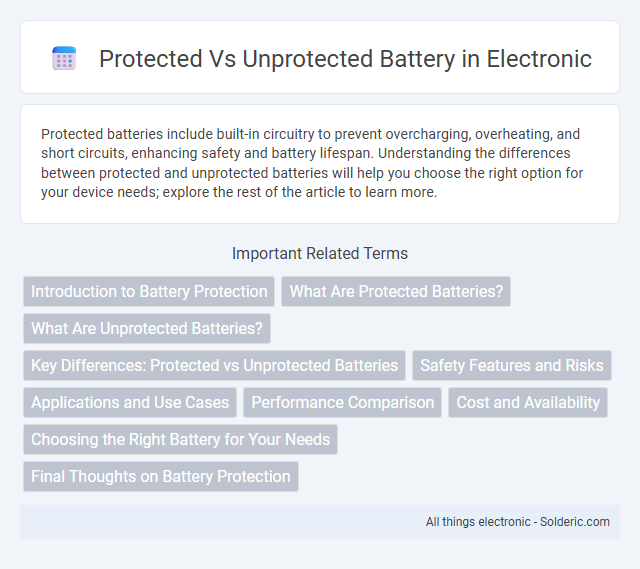Protected batteries include built-in circuitry to prevent overcharging, overheating, and short circuits, enhancing safety and battery lifespan. Understanding the differences between protected and unprotected batteries will help you choose the right option for your device needs; explore the rest of the article to learn more.
Comparison Table
| Feature | Protected Battery | Unprotected Battery |
|---|---|---|
| Safety Circuit | Included - prevents overcharge, over-discharge, and short circuit | Not included - no built-in safety protection |
| Size | Slightly larger due to protection circuit | Smaller and more compact |
| Price | Higher cost from added circuitry | Lower cost, no extra components |
| Use Case | Safe for general consumer electronics and beginners | Preferred by experienced users and devices with built-in protection |
| Performance | May have slightly reduced capacity due to protection board power draw | Full battery capacity available |
| Risk | Lower risk of battery damage and hazards | Higher risk if misused or improperly charged |
Introduction to Battery Protection
Battery protection circuits are essential in preventing short circuits, overcharging, and deep discharging that can damage lithium-ion or lithium-polymer cells. Protected batteries include built-in safety mechanisms such as PTC resettable fuses and voltage cutoff circuits, which enhance battery lifespan and device reliability. Choosing a protected battery ensures safer operation and minimizes risks associated with battery failure, safeguarding your electronic devices.
What Are Protected Batteries?
Protected batteries incorporate a built-in circuit that prevents overcharging, over-discharging, short circuits, and overheating, ensuring enhanced safety and longevity. This protective mechanism safeguards your devices by automatically cutting off power during unsafe conditions, making them ideal for beginners or devices lacking internal protection. Unprotected batteries lack this circuitry, posing higher risks but often providing higher current capabilities and more compact designs.
What Are Unprotected Batteries?
Unprotected batteries lack internal circuitry to prevent overcharging, over-discharging, and short circuits, which can lead to safety risks such as overheating or fires. These batteries rely on external devices or chargers to manage charging parameters and ensure safe operation. Choosing unprotected batteries requires careful monitoring, as Your device's safety depends on proper handling and compatible protection mechanisms.
Key Differences: Protected vs Unprotected Batteries
Protected batteries feature built-in circuitry that prevents overcharging, short-circuiting, and overheating, enhancing safety and battery lifespan. Unprotected batteries lack these safety mechanisms, making them more susceptible to damage and potential hazards during improper use. Understanding these key differences helps you choose the right battery for your device's safety requirements and performance needs.
Safety Features and Risks
Protected batteries include built-in safety features such as overcharge, over-discharge, and short circuit protection circuits, reducing the risk of overheating, fire, or explosion. Unprotected batteries lack these safeguards, making them more susceptible to damage from improper use or faulty chargers, which can compromise your device's safety. Choosing a protected battery ensures enhanced reliability and longevity by mitigating common electrical risks during operation.
Applications and Use Cases
Protected batteries include built-in circuit boards that prevent overcharging, short circuits, and overheating, making them ideal for devices like laptops, smartphones, and power tools where safety and longevity are critical. Unprotected batteries, lacking these safety features, are often used in DIY electronics, flashlights, and RC vehicles where size and cost are priorities, but users must monitor them closely to avoid damage. Selecting the right battery type ensures your device operates safely and efficiently within its intended application.
Performance Comparison
Protected batteries feature built-in circuitry that prevents overcharging, short circuits, and overheating, enhancing safety but slightly reducing capacity and discharge rates compared to unprotected batteries. Unprotected batteries typically offer higher performance in terms of energy output and runtime due to the absence of safety circuits, but they carry a greater risk of damage and safety hazards under improper usage. The choice between protected and unprotected batteries depends on the application's priority for safety versus maximum power delivery and efficiency.
Cost and Availability
Protected batteries generally cost more due to built-in circuitry that prevents overcharging, short circuits, and over-discharge, enhancing safety and lifespan. Unprotected batteries are cheaper and more widely available because they lack these protective features, appealing to budget-conscious users or applications requiring compact designs. Availability of protected batteries is increasing as demand grows for safer power sources in devices like laptops, power tools, and electric vehicles.
Choosing the Right Battery for Your Needs
Choosing the right battery depends on your device's safety requirements and usage patterns; protected batteries include built-in circuitry to prevent overcharging, short circuits, and overheating, making them ideal for devices with sensitive electronics or frequent use. Unprotected batteries offer higher capacity and smaller size but require external protection and are better suited for experienced users or devices with dedicated battery management systems. Understanding the balance between safety features and power needs ensures optimal performance and longevity in your electronics.
Final Thoughts on Battery Protection
Battery protection is crucial for extending the lifespan and ensuring the safety of your lithium-ion cells by preventing overcharge, over-discharge, and short circuits. Unprotected batteries may offer higher capacity but pose significant risks of damage or even fire without built-in safeguards. Choosing a protected battery guarantees more reliable performance and peace of mind for your device's operation.
Protected vs Unprotected battery Infographic

 solderic.com
solderic.com